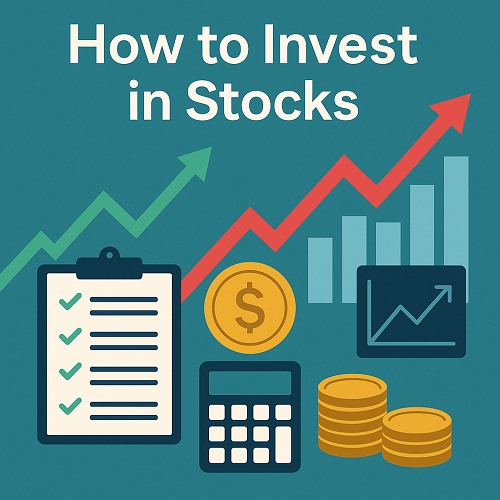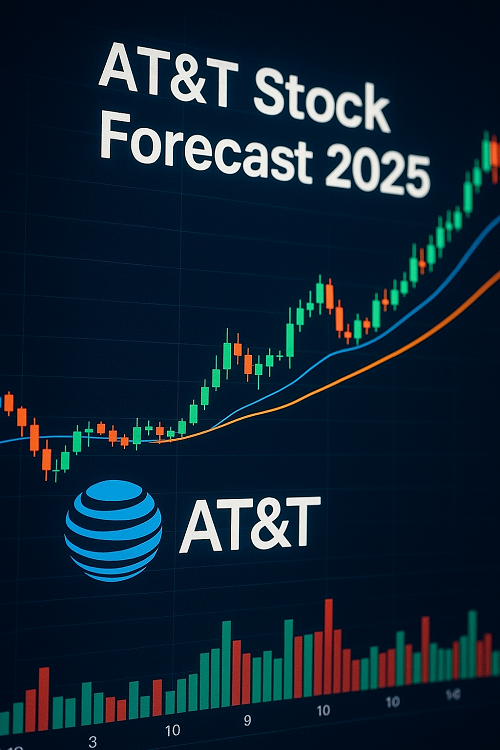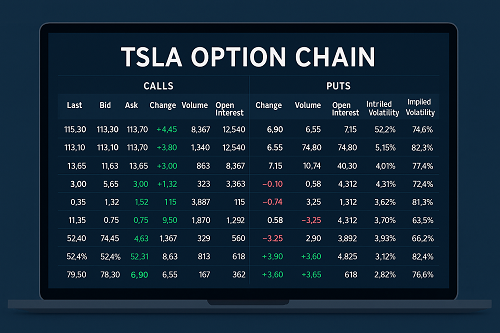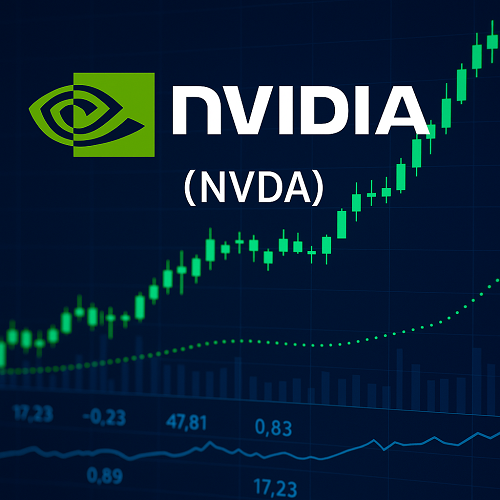Why Stocks?
When you invest in stocks, you might want to create an image related to this blog post to illustrate the potential growth and opportunities that investing offers. Investing in stocks offers:
- Long-term growth potential that outpaces inflation
- Liquidity — easily bought and sold
- Ownership equity in companies — aligning your gains with business success
- Dividend income potential
- Access to sectors, themes, innovation (tech, biotech, green energy)
Historically, the U.S. equity market has returned ~9–10% annually (nominal) over long horizons. But that’s an average — your returns will depend heavily on timing, discipline, diversification, and fees.
Important caveat: Stocks are volatile. They’re not appropriate for money you’ll need in the short term. Use cash or safer instruments (bonds, money market) for your short-term goals.
Key Concepts & Terminology
Before diving in, here are essential terms you should know:
| Term | Definition |
|---|---|
| Equity / Stock | Ownership share in a company |
| ETF (Exchange-Traded Fund) | Fund that trades like a stock, tracking an index or strategy |
| Mutual Fund | Pooled investment vehicle, might have minimums and trade less frequently |
| Dividend Yield | Annual dividend ÷ stock price |
| P/E Ratio | Price-to-Earnings ratio — valuation metric |
| Beta | Measure of volatility relative to the market |
| Alpha | Excess return relative to benchmark |
| Sharpe Ratio | Risk-adjusted return measure |
| Rebalancing | Adjusting weights to target allocations |
| Fractional Shares | Ability to buy partial shares |
| Limit / Market / Stop / Stop-Limit Orders | Different order types to optimize execution |
As you read on, keep these in mind — they’re the vocabulary you’ll use to execute real trades.
Step-by-Step Process to Invest in Stocks
Decide Your Role: DIY vs. Advisor / Robo vs. Manual
- DIY (You pick and manage everything) — gives maximum control, but requires time, research discipline, and emotional fortitude.
- Robo-advisors / Automated services — algorithm-driven allocation, periodic rebalancing, lower fees, minimal hassle.
- Full-service financial advisors / wealth managers — ideal if you have more capital and prefer human guidance; expect higher fees.
Hybrid model: Use robo/advisor for core portfolio + tactical DIY for a small satellite allocation.
Choosing a Brokerage / Platform
Key selection criteria:
- Fees & Commissions — Many brokers now offer $0 commission on U.S. stocks and ETFs.
- Selection of securities — international stocks, ADRs, options, derivatives, fractional shares.
- Research & Tools — screening, charting, backtesting, news feeds.
- Execution speed & reliability — critical especially if you ever trade more actively.
- Regulation & Security — Is the broker regulated (SEC, FINRA, etc.)? What’s its custodial protection?
- Ease of funding / withdrawal — bank transfers, wire, etc.
- Margin / Leverage availability — if you plan to use margin, check rates.
Examples (U.S. / global): Interactive Brokers, TD Ameritrade / thinkorswim, Schwab, Fidelity, eToro, Webull, etc.
Selecting the Right Account Type
Which account you choose can strongly impact taxes and flexibility:
- Taxable brokerage — full flexibility, but capital gains taxed.
- Retirement / tax-advantaged accounts (IRA, Roth IRA, 401(k), TFSA/Cel for Canada, etc.) — tax benefits, but withdrawal rules apply.
- Custodial accounts — for minors (UTMA, etc.).
- Trust or entity accounts — for estates or business holdings.
Choosing the right mix depends on your country’s tax regime, time horizon, and liquidity needs.
Funding Your Account & Capital Allocation
- Start with an emergency fund (3–6 months of expenses) before placing money into stocks.
- Decide how much capital you’ll deploy now vs. reserve for future opportunities.
- Use a staggered approach (e.g. deploying in tranches), especially in turbulent markets.
- Consider dollar-cost averaging to mitigate timing risk (more on that later).
Picking Investments: ETFs, Mutual Funds, vs. Individual Stocks
Core portfolio via diversified vehicles:
- Broad market ETFs (e.g., S&P 500, Total Market, MSCI All Country)
- Factor-based or smart-beta ETFs (value, momentum, low volatility)
- Sector / thematic ETFs (e.g. AI, biotech, climate tech)
Satellite / tactical picks (individual stocks):
- Use fundamental screening — revenue growth, margins, competitive moats
- Technical analysis to time entries (support, trend, volume)
- Focus on champion stocks in your circle of competence
- Limit position size (e.g. ≤ 2–5% of total portfolio)
Execution: Order Types, Timing, Fractional Shares
Understanding order types helps:
- Market orders: executed immediately, but may slip
- Limit orders: you dictate max/min price
- Stop / stop-limit orders: trigger orders when price crosses a threshold
- Trailing stop orders: dynamic stops that adjust as price moves
Also, fractional shares let you invest exactly $100 in a $1,000 stock (0.1 share). Ideal for small portfolios.
Timing — hitting exact bottoms or tops is impossible. Use limit orders, avoid impulsive trades, and think in terms of weeks/months rather than hours.
Portfolio Construction & Diversification
A robust portfolio balances return and risk:
- Asset allocation — stocks vs bonds vs cash
- Sector / industry diversification
- Geographic diversification — U.S., developed ex-US, emerging markets
- Factor diversification — growth, value, momentum, etc.
- Correlation awareness — avoid overlapping bets
Use a core-satellite approach: core 70–90% in diversified funds, satellite 10–30% in higher-conviction individual names.
Ongoing Management & Rebalancing
- Rebalance periodically (e.g. semiannual or annual) to maintain target weights
- Use tax harvesting where possible (if allowed in your jurisdiction)
- Monitor for corporate actions (splits, dividends, spin-offs)
- Graduated shift: as you age or approach goals, gradually tilt toward more defensive allocations
Advanced Tactics & Strategies
Now, the “next-level” investing tools and approaches that go beyond basics.
Factor Investing & Smart Beta
Rather than purely market-cap indexes, many modern ETFs and strategies tilt toward “factors” like:
- Value (low P/E, low P/B stocks)
- Momentum (stocks with strong recent performance)
- Size (small-cap vs. large-cap)
- Quality (strong balance sheets, low debt)
- Low Volatility (stable, less reactive stocks)
These factor-tilted ETFs can improve risk-adjusted returns and reduce exposure to extremes.
Sector Rotation & Thematic Investing
Some investors shift sector allocations based on macro trends (interest rates, trends like AI, ESG, cloud computing).
But it’s dangerous to over-rotate — keep core stable, use sector bets judiciously.
Dividend Growth & Income Investing
Some stocks / ETFs focus on growing dividends (e.g. dividend aristocrats). The advantage:
- Income buffer during flat markets
- Compounding via dividend reinvestment
- Defensive tilt
Drawback: slower growth.
Value vs. Growth vs. Momentum
- Value seeks undervalued stocks
- Growth prioritizes high earnings, revenue trajectories
- Momentum captures continuation of trends
A diversified approach often blends the three, adjusting weights based on market regime (e.g. value-friendly vs growth-friendly periods).
Dollar-Cost Averaging & Tactical Adjustments
Dollar-cost averaging (DCA) smooths entry risk, especially in volatile environments.
Tactical adjustments: if you detect overbought signals, you might temporarily slow new allocations or hedge slightly (e.g. via options or inverse ETFs).
Risk Management & Behavioral Pitfalls
Tell yourself: “The first rule of investing is don’t lose money.”
- Position sizing: Avoid making any single bet too large
- Use stop-losses (though carefully — avoid being stopped out in normal volatility)
- Hedging when appropriate (e.g. options, inverse ETFs, protective puts)
- Avoid emotional trading — fear & greed are your greatest enemies
- Overtrading is a return killer
- Recognize recency bias, confirmation bias, anchoring, loss aversion
- Maintain a written investment policy statement (IPS) you commit to
Global Markets & International Stock Exposure
Don’t limit yourself to one country. Global exposure can smooth volatility and capture growth from developing economies:
- Developed markets: Europe, Japan, Australia
- Emerging markets: China, India, Latin America
- Frontier markets (small, nascent) — higher risk, higher reward
- Use ETFs (e.g. MSCI ACWI ex-US, emerging-market ETFs)
- Consider currency exposure / hedging
Tax Efficiency & Withdrawal Strategies
Taxes can erode your returns. Key ideas:
- Place tax-inefficient assets (e.g. REITs, high-turnover funds) in tax-advantaged accounts
- Use tax loss harvesting strategically
- Understand long-term vs. short-term capital gains tax rates in your jurisdiction
- Use dividend-qualified stocks / ETFs for lower tax rates
- When withdrawing, follow bucket strategies (liquidate less efficient holdings first)
- Plan Roth conversions, if applicable
Tools, Data & Resources
- Stock screeners & backtesting platforms (e.g. Finviz, Portfolio Visualizer, TradingView)
- APIs / data feeds (Alpha Vantage, Yahoo Finance, Zacks, etc.)
- Portfolio trackers / aggregators
- Financial news / research services (e.g. Seeking Alpha, Morningstar, Bloomberg, Atom Finance)
- Paper trading / simulation before deploying capital
- Algorithmic tools / bots (if you advance into quantitative investing)
Case Study: Portfolio Build from $10,000
Let’s walk through a hypothetical:
- Core (70%): $7,000 → U.S. total market ETF + Global ex-U.S. ETF
- Satellite (30%):
• $10% ($1,000) in a high-conviction growth stock
• $10% ($1,000) in a dividend-growth ETF
• $10% ($1,000) in a thematic / sector bet (e.g. AI, clean energy)
Over time, you rebalance yearly. Suppose the growth stock outperforms, pushing allocation to 40% — you sell partial to return to 30%.
Track performance, risk metrics (volatility, drawdown), and refine as you gain experience.
FAQs & Myths Debunked
Q: Do I need a lot of money to start?
A: No. Many brokers allow fractional shares; you can begin with $50–$100. The key is consistency, not capital.
Q: Is timing the market possible?
A: Very rarely. Most outperformance comes from staying invested, compounding, and avoiding disastrous drawdowns.
Q: Are stock apps safe?
A: Yes, provided the broker is regulated, funds are custodial, and two-factor authentication is used.
Q: Should I try day trading?
A: Not at first. Most beginners underperform. Start with a long-term mindset.
Q: Will I beat the S&P 500?
A: Often not. Many professional fund managers underperform when fees are considered. That’s why low-cost index investing is a smart baseline.
Final Checklist & Next Steps
✔ Define your investment goals and time horizon
✔ Choose your role (DIY, robo, advisor)
✔ Select the right brokerage / platform
✔ Determine account types and tax considerations
✔ Allocate capital intelligently
✔ Build a core-satellite portfolio
✔ Use factor tilts and sector bets as supplements
✔ Monitor and rebalance periodically
✔ Keep emotion in check; follow your IPS
✔ Use tools and data to refine over time





 XAUT-USD
XAUT-USD  AMD
AMD  MARA
MARA  SHOP
SHOP  BULL
BULL  CL=F
CL=F